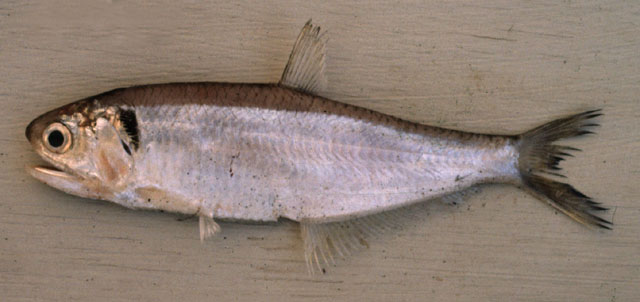| Engraulidae (Anchovies), subfamily: Coiliinae |
| 19 cm TL (male/unsexed); 20.5 cm TL (female); max.weight: 60.7 g; max.weight: 70.0 g |
|
pelagic-oceanic; brackish; marine; depth range 0 - 50 m, oceanodromous |
| Indo-West Pacific: western coast of India to Myanmar and south to Java, Indonesia. |
|
Dorsal spines (total): 0-0; Anal spines: 0-0; Anal soft rays: 29-37. Belly with 24 to 32 keeled scutes from isthmus to anus. Tip of snout on a level with eye center. Maxilla long, reaching to or almost to base of first pectoral fin ray; first supra-maxilla oval, minute. Lower gill rakers with serrae on the inner edge even and not clumped. A dark blotch behind upper part of gill opening. |
| Found in coastal pelagic waters and often observed as entering mangroves and adjacent brackish waters (Ref. 43081). Juveniles and adults may penetrate the upper reaches where mixohaline-mesohaline conditions prevail. Eggs and larvae are found in the lower reaches of the mangroves (Ref. 43081). A schooling species found mostly inshore. Feed on planktonic organisms in coastal waters (Ref. 43081). Juveniles in mangroves feed on larvae of shrimps and fish (Ref. 43081). Confusions in identification make all previous biological studies unreliable. One of the commonest species of Thryssa (if identifications have been correct). |
|
Least Concern (LC); Date assessed: 10 December 2019 Ref. (130435)
|
| harmless |
Source and more info: www.fishbase.org. For personal, classroom, and other internal use only. Not for publication.

